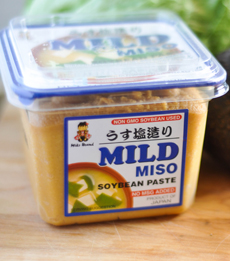TIP OF THE DAY: Ways To Use Miso Paste
|
|
Almost everyone who has been to a Japanese restaurant has had miso soup. But today’s tip includes other things to do with miso (MEE-zoe).
Thanks to the popularity of miso, you can find at least one type of miso paste in many supermarkets and all natural foods stores (Whole Foods and Trader Joe’s, for example). Miso is a paste made from soybeans and grains (typically barley or rice), koji (a fungus that serves as a fermenting agent) and sea salt. It can ferment from a short time (for mild homemade miso) to three years (for red miso). The result has the consistency of hummus. The fermentation produces an enzyme-rich, living food that contains many beneficial microorganisms. However, it also has a relatively high salt content. Miso should be refrigerated and added to cooked foods just before they are removed from the heat. |
|
|
TYPES OF MISO PASTE Different types of miso paste are available in Japanese markets (like Sunrise Mart in New York City). Natural food stores typically carry the three most common. The deeper the color, the higher the percentage of soybeans and the stronger the flavor. In Japan, miso soup is a culinary staple, whisked into dashi (stock) and enjoyed at any meal, starting with breakfast. It is also used to give an earthier flavor to noodle soups, such as ramen and udon. It is also used as a condiment/seasoning: |
||
|
Americans have incorporated miso into Western cuisine, from gravy to risotto and quich. For inspiration, pick up a book like The Miso Book: The Art of Cooking with Miso. It not only has many recipes, but shows you how to make your own miso paste from scratch.
Start by making miso soup and salad dressing with the recipes below. RECIPE: EASY MISO DRESSING Ingredients |
 A familiar bowl of miso soup (photo courtesy Sushi Lounge | Morristown, NJ). |
|
|
1. WHISK the ingredients in a bowl until smooth. Taste and add more honey or vinegar as you prefer. 2. STORE leftovers in the fridge for up to a week. Ingredients 1. ADD the water into a pot and bring to a boil. Add the instant dashi; whisk to dissolve. Turn the heat to medium-low and add the tofu and seaweed. Simmer for 2 minutes. While the soup simmers… 2. SPOON the miso paste into a bowl. Ladle 1/2 cup of the hot dashi broth into the bowl and whisk until the miso paste melts and is the mixture smooth. 3. TURN off the heat and add the miso paste to the pot. Stir well. Taste the soup and whisk in another 1-2 tablespoons of miso paste as desired. Garnish with green onions and serve immediately.
|
||
